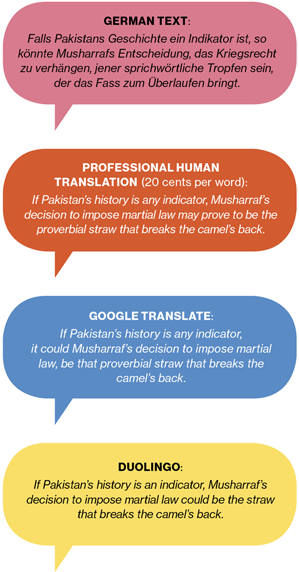
Best babble: A comparison of translations by human experts, automated software, and Internet crowds.
Learning a new language is tedious and demands a lot of practice. Luis von Ahn doesn?t want all that effort to be wasted. In fact, it might be a gold mine.
Von Ahn, a computer science professor at Carnegie Mellon University, is the co-creator of Duolingo, a free language-?learning site that turns students into an online workforce. His software uses their answers to simple exercises in a translation service that he expects to charge money for.
It?s clever stuff: an education that pays for itself. That achievement is important as education moves toward being given away online (see ?The Most Important Educational Technology in 200 Years?). Teachers and universities are now running into the same problem journalists and movie studios have faced: how will they make any money if the content is free? No matter how cheap it is to pipe information across the Web, producing lessons and coursework is still demanding and expensive.
Duolingo, which launched in June, has raised $18.3 million in venture funding (see ?Startup Has Language Learners Translating the Web?). It offers English lessons for Spanish and Portuguese speakers and lessons in Spanish, German, French, and Portuguese for English speakers. Around 300,000 people now use it each week.
The company is going up against popular language software such as Rosetta Stone (itself a less costly alternative to in-person lessons). But von Ahn thinks he has the edge, and not only because his classes are free.
?Most language-learning software providers have no incentive for you to learn,? he says. ?Once [they] get your $500, they?re happy. We?ll do a lot to get you to come back, because it really matters.? His hoped-for translation business depends on it.
That?s why the company?s 20 employees in Pittsburgh spend most of their time getting the software to teach better. Von Ahn says that so far about 30 percent of people who start learning a language will still be visiting the site a week later. That figure may sound low, but it?s impressive for any Web service, he says. Duolingo users are drilled on new words using both written exercises and audio (the software can detect and assess their pronunciation). As they progress, their performance is used to decide what lessons they get next.
It adds up to a free course several hundred hours long that can take a student from zero knowledge of a second tongue to what von Ahn describes as ?intermediate level? ability?the kind you?d need to get by on a foreign vacation or grasp the gist of a newspaper article.
The other side of the business comes in when students are asked to practice by translating single sentences from one language to another. Those sentences are currently taken from sites von Ahn thinks should be translated anyway, such as English Wikipedia articles without equivalents in Spanish.
Multiple students translate the same sentence; software compares those results to settle on a final translation. After many sentences are put through this process, they are combined to create a translation of an entire document. The results, says von Ahn, are better than an automated translation but typically just short of professional quality.
Duolingo?s translation service is currently free, but by early next year the company intends to begin charging for ?rush jobs? that have a deadline. Von Ahn says Duolingo will ask for less than the five to 20 cents a word that professional translators charge. The service is in pilot tests with a big media company, he says.
An inexpensive translation service could solve some big problems, particularly for newspapers in U.S. cities with large Hispanic populations. In August, for instance, the Hartford Courant launched a Spanish-?language edition. But it was produced almost entirely using Google Translate. The results, which were spotty, drew negative reactions. (The newspaper later abandoned the idea.)
This isn?t the first time von Ahn has found a clever way to distribute small tasks among many people to solve a challenge, an approach he dubs human computation. He created something called the ESP Game, which turned labeling computer images into an online challenge. Google licensed that technology for its search engine and later also acquired ReCaptcha, a system Von Ahn created to help digitize blurry old books. Those distorted letters a website will sometimes ask you to copy to show you are human? That?s ReCaptcha getting you to decipher text a computer can?t.
Duolingo?s design is inspiring others to look for new ways to apply human computation in education. ?I think Duolingo is incredibly exciting,? says Dan Weld, a professor of computer science at the University of Washington who helped organized a workshop last summer on how to use crowdsourcing in education.
Weld thinks such methods could, for instance, turn students into a workforce that could correct or score the work of other students learning online. That could overcome a major shortcoming of massive open online courses, or MOOCs, which are encountering problems grading the work of tens of thousands of students.
There?s a ?groundswell? in online education, says Weld. ?But a lot of it is prepackaged video clips and other things we tried a long time ago that didn?t go anywhere. We need more power and personalization.? Achieving that solely with software is unlikely, he says, but properly directed crowds could provide the necessary intelligence.
Von Ahn has his own ideas along these lines. For example, he hopes to use the work of students who are learning computer languages online at places like Codecademy (see ?Startups Aim to Make Coding Fun?). ?You could imagine something with programming, maybe finding bugs in software as part of a course,? he says. ?We may try it.??
Source: http://www.technologyreview.com/news/506656/the-cleverest-business-model-in-online-education/
pietrus cheney tori spelling marion barber marion barber syracuse ohio state
No comments:
Post a Comment
Note: Only a member of this blog may post a comment.